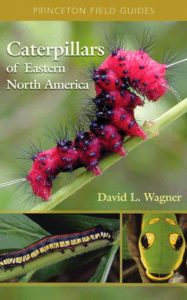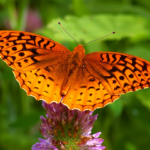The problem with many butterfly gardens is that they tend to be butterfly nightclubs. Basically, these gardens are for adults. Take the ubiquitous butterfly bush (Buddlia davidii) for example. You may find it covered with butterflies, but where are the caterpillars? Not only is butterfly bush now on many invasive species lists, it provides virtually no food value to caterpillars, i.e. butterflies during childhood. It is basically a place where grownup butterflies go for a drink. So create a butterfly garden and caterpillar nursery by following the tips below.
Starting your butterfly garden
For a garden that addresses the needs of butterflies throughout their lives, what should you plant? Every good parent knows that a healthy childhood is critical for their offspring. Of course, this requirement includes butterflies. While humans try to provide a stimulating, caring, and healthy home or daycare facility for their children, butterflies look for rich gardens with the right plant material for their caterpillars.
Although this makes designing a butterfly garden more complicated than simply planting flowers, there are some valuable resources available to you. My favorite is called Caterpillars of Eastern North America by David L. Wagner.
This reference not only helps you identify caterpillars (the larval stage of the butterfly), it shows you pictures of the butterflies that they become. It even has a Foodplant Index in the back which lists plants and then references the caterpillars that eat that particular plant.
Identify caterpillars
For example, one day you find a caterpillar on your parsley. Will it become a beautiful butterfly, or is it a pest eating your herbs? Using the Foodplant Index, you can look up parsley and discover that the caterpillar is a black swallowtail. Interestingly, these caterpillars eat anything in the carrot family. So if you happen to have Queen Ann’s Lace around, you can pick the caterpillar off of your parsley and move it to the Queen Ann’s Lace. This saves your parsley and keeps the caterpillar happy in the process. If you don’t have Queen Ann’s Lace, you may decide to sacrifice your plant for the butterfly and pick up some parsley at the store.
Attract Butterflies with the Right Plants
Another way to use this book, is that you can reference the host plants for specific butterflies. As an example, you want to attract Tiger Swallowtails. If you look up the caterpillar you will see that it eats sweetbay magnolia (Magnolia virginiana), tulip poplar (Liriodendron tulipifera) and cherries (Prunus sp). You can then plant a sweetbay magnolia to attract Tiger Swallowtails.
You may even find this approach changes the way you garden. For instance, you may have been fighting violets in your garden for years. However, upon investigation you find that violets are the only food source for one of our most beautiful butterflies, the Great Spangled Fritillary. Now you see violets as an asset, and decide to leave at least some for the butterflies. This results in less work for you and more food for the caterpillars. Now that is a win-win!
The point of this is, if you want a butterfly garden, think more nursery than nightclub. Your whole property should be full of diverse plantings to feed a variety of caterpillars. Provide a healthy childhood atmosphere for the butterflies, and when they grow up they can hang out at the clubs.




